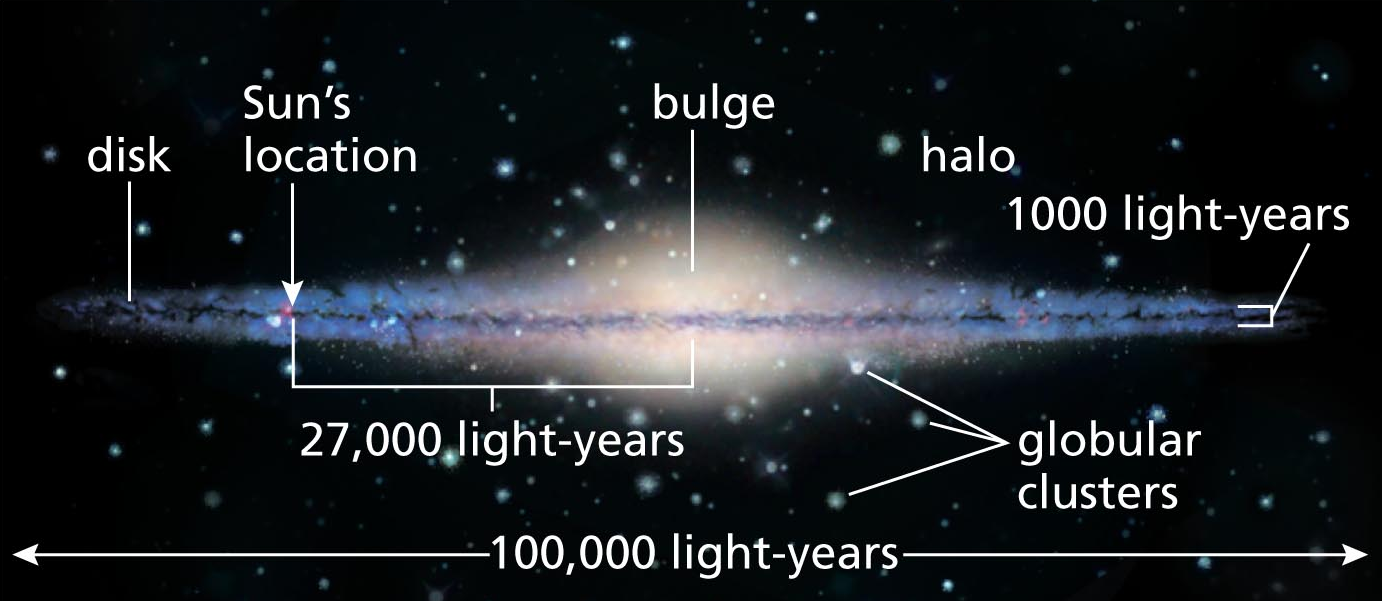The Milky Way
Jed Rembold
March 05, 2024
Announcements
- HW3 due tonight!
- The debriefing form will open up at midnight and be available until Thursday night
- HW4 is posted!
- Partner meet-n-greet at the end of class today
- My work on HW2 feedback continues, which I feel bad about. Please know I’m really trying.
Discussing Today
- Determining the structure of the Milky Way
- Distances beyond parallax
The Milky Way
To the Greeks appeared as a ribbon of milk across the sky
- Likely the source of its name
- Greek word for milk: galactose
Galileo was the first to turn a telescope upon it:
The galaxy is, in fact, nothing but a collection of innumerable stars grouped together in clusters. Upon whatever part of it the telescope is directed, a vast crowd of stars is immediately presented to view. Many of them are rather large and quite bright, while the number of smaller ones is quite beyond calculation.
Galileo Galilei, The Starry Messanger (1610)
Shaping a Picture
- Determining the size and shape of an object an observer is within can be tricky
- How could you try to estimate the size and shape of
Collins, without leaving this room?
- We can’t see through walls, so visible obstructions are a serious problem
- Exterior windows aren’t really giving us a view of
the building
- Probably on the edge then?
- Looking through the interior window:
- A portion of hallway and another classroom
The Story of a Band
- If the Milky Way appears as a band across the sky, what does that
tell us?
- We see way more stars looking in a specific direction than most others
- The galaxy must be fairly flat
Measuring the Galaxy
- In the early 1800’s, William and Caroline Herschel tried counting stars in different directions
- They concluded:
- The Milky Way was 5 times as wide as it was thick
- The Sun was approximately at the center
- There were several branches

What went wrong?
- Herschel had no way of knowing about how huge stellar distances were
- The first parallax measurements were gotten 15 years after his death
- Didn’t realize it would be impossible to “see” to the edge of the
galaxy
- Most stars would have been far too faint to see with his telescope
- Plus, much of the galaxy is obscured by opaque (to visible light) dust!

Variations on the Theme
- Harlow Shapley attempted to do similarly, but instead used counted
globular clusters
- Globular clusters live mostly above or below the dust band
- Contain many stars, and thus are easier to see and measure from a greater distance
- Findings:
- An approximately spherical distribution
- Definitely not centered on the Sun

Equatorial Conversions
- To do these sorts of calculations, it necessitates being able to convert between coordinate systems
- Observations most likely made in equatorial coordinates, which need to be converted to a Cartesian system \[ \begin{aligned} X &= R \cos(\delta)\cos(\alpha) \\ Y &= R \cos(\delta)\sin(\alpha) \\ Z &= R \sin(\delta) \end{aligned} \] where \(R\) is the distance away, \(\delta\) the declination and \(\alpha\) the right ascension.
- Note that these conversions place the XY plane as bisecting the equatorial sphere at the equator, which may not align with the plane of the galaxy
Activity!
- The file here contains equatorial positions for 10k stars as seen from a simulated planet within the small elliptical galaxy
- You can assume the measurements are accurate enough to see and measure most of the star positions in the galaxy (or at least a representative sample)
- How far is the planet from which the observations were made from the center of the galaxy?
Galactic Distances
- Most methods of determining shape rely heavily on accurate distance measurements
- But we can only measure parallax distances for the very nearest stars!
Moving up the Distance Ladder
- As we venture further, we need new ways to determine the distances to objects
- Some include:
- Main sequence fitting: comparing cluster HR diagrams to theoretical diagrams
- Variable Stars:
- RR Lyrae
- Cepheid Variables
Cepheids
- Giant stars with very predictable pulsations in brightness
- Located along the instability strip in an HR diagram

Time = Power!
- In 1912 Henrietta Leavitt noticed for cepheid variables in the Small
Magellanic Cloud had:
- Higher luminosities
- For longer pulsation periods
- This gives an easy way to determine luminosities!
- Which then gives us distances!

Putting it Together

Orbital Paths

HW4 Partners!
- You have the rest of class to meet up with your new partner for HW4 and start to plan ahead
- Teo and Indi
- Dash and Nico
- Paul and Owyn
- Siera and Matthew
- Trajan and Zachary
- Jennifer and Brandon
- Sam and Kendall
- Ben and Sophia
- Alex and Teddy
- Mia and Michael
- Leila, Nathaniel, and Kara
